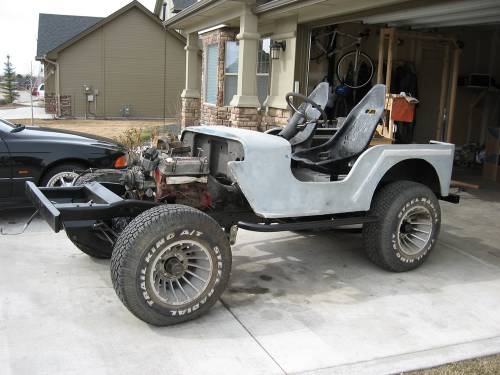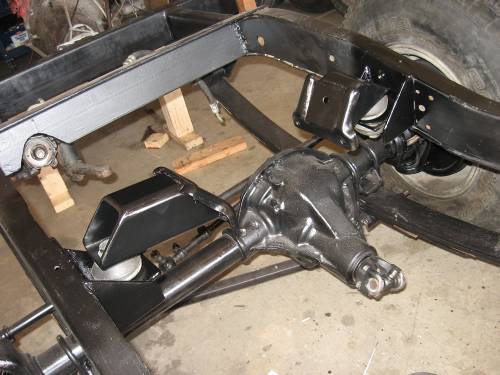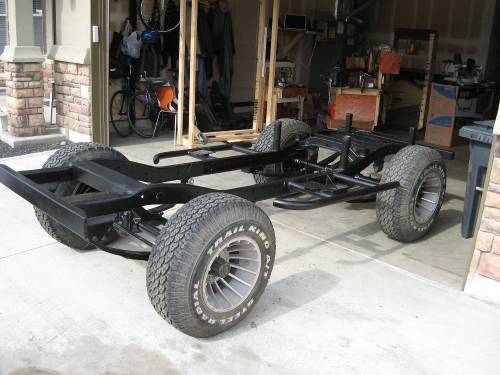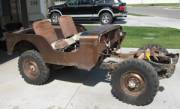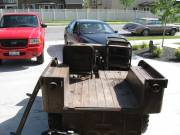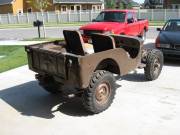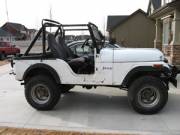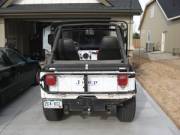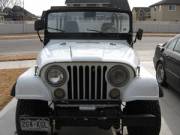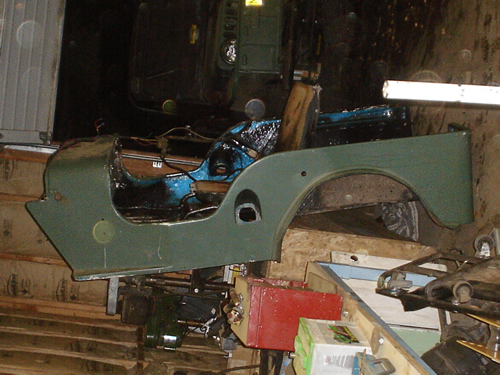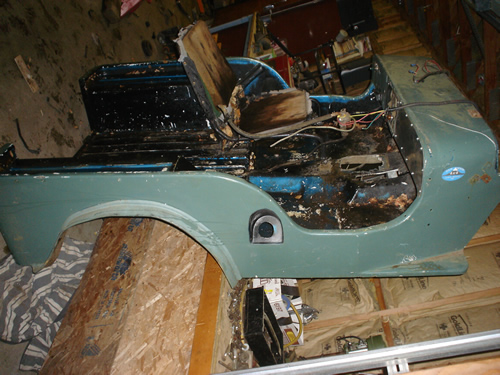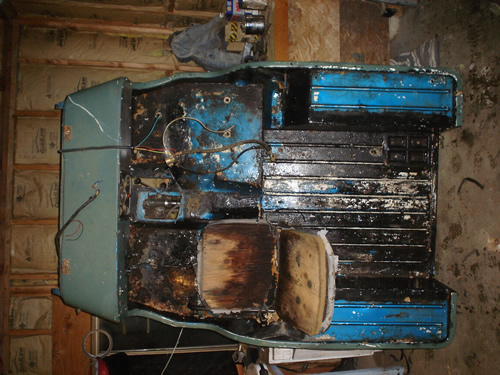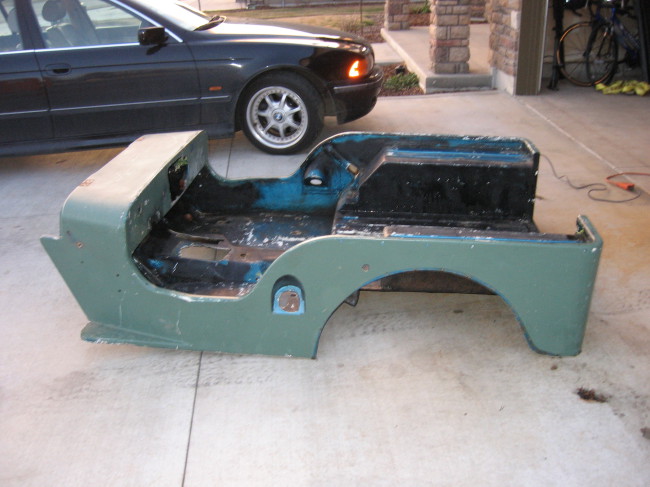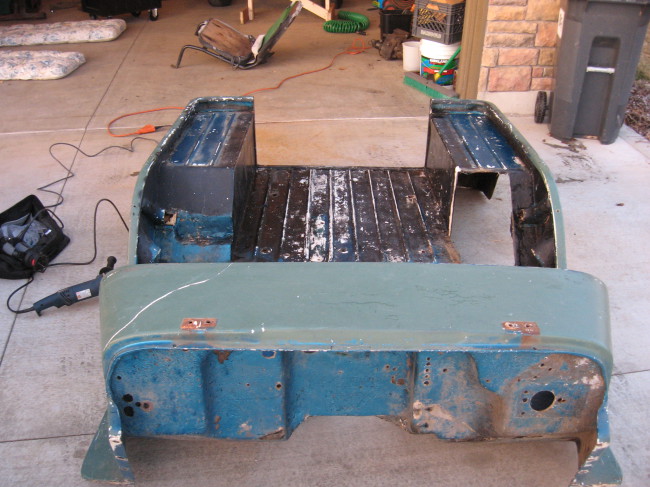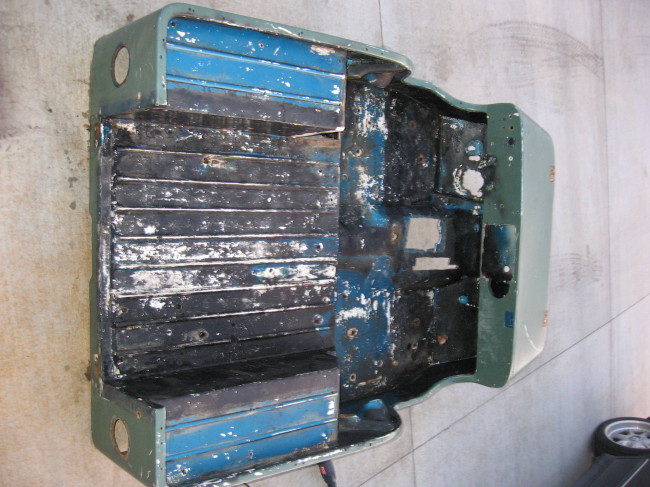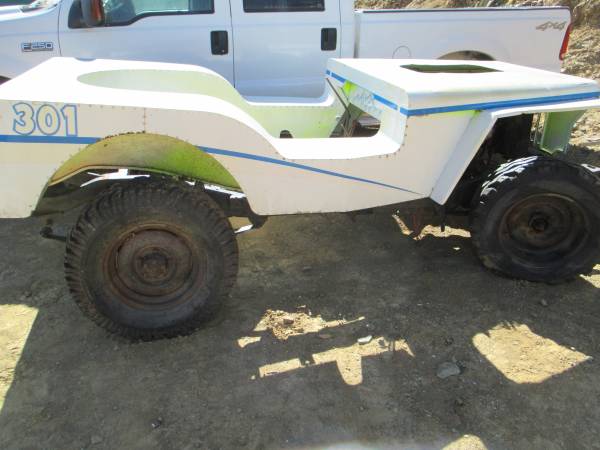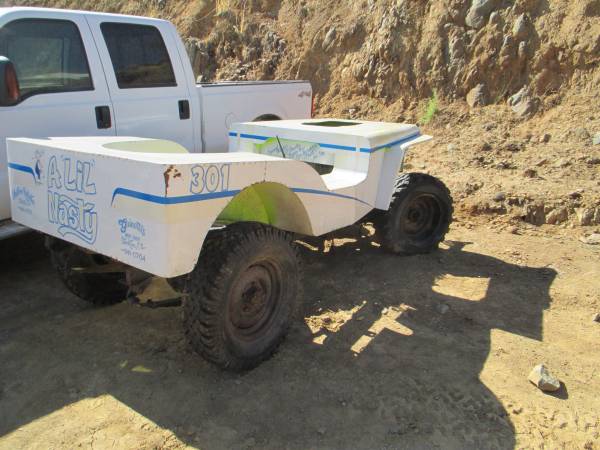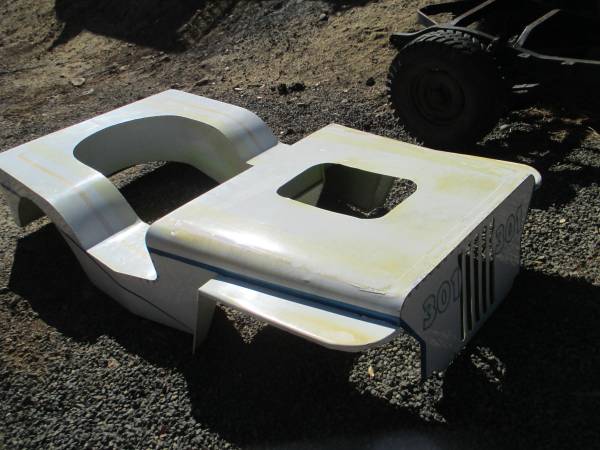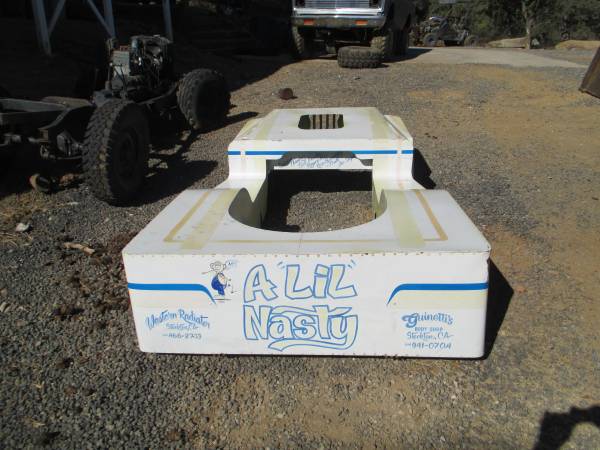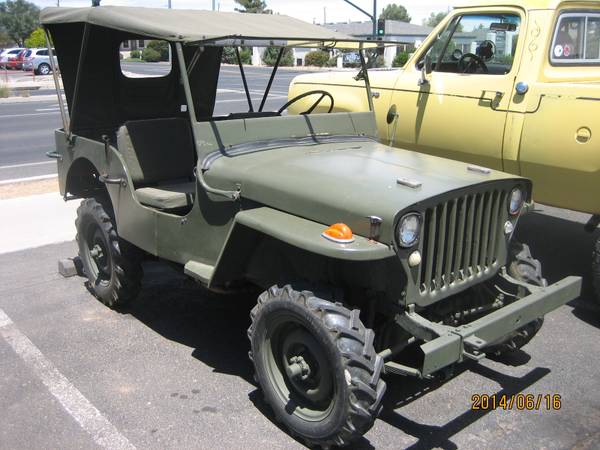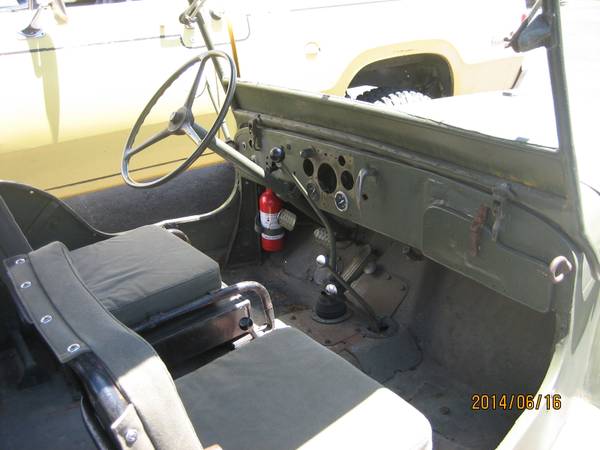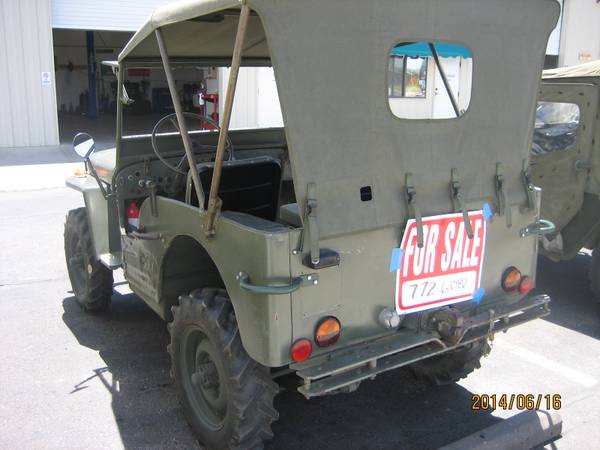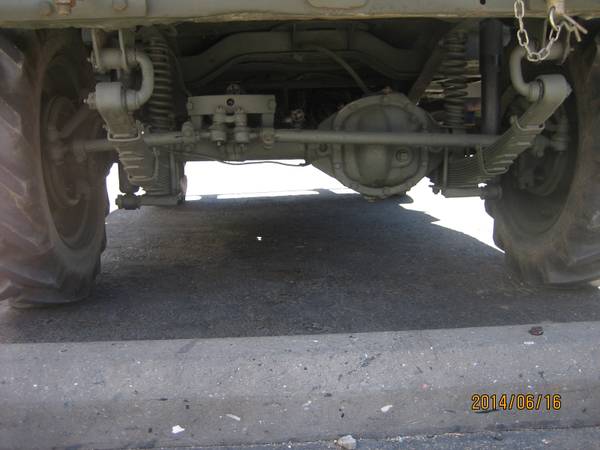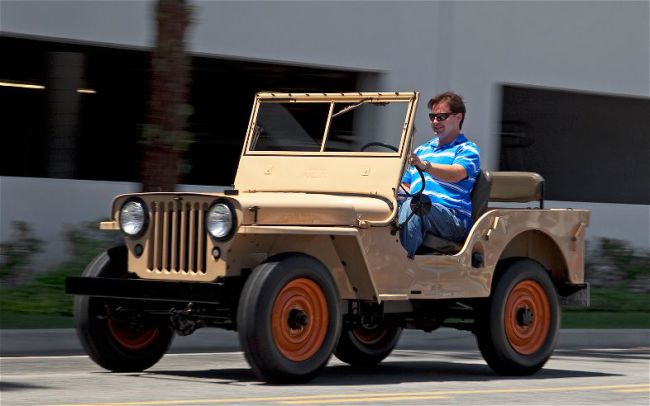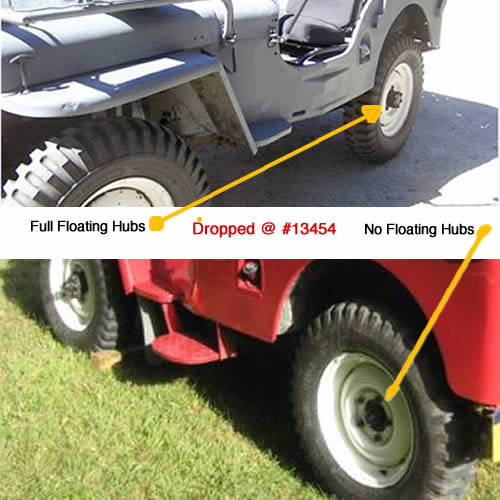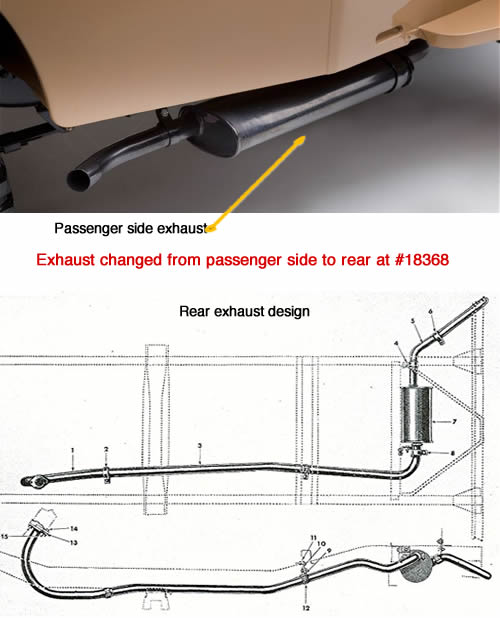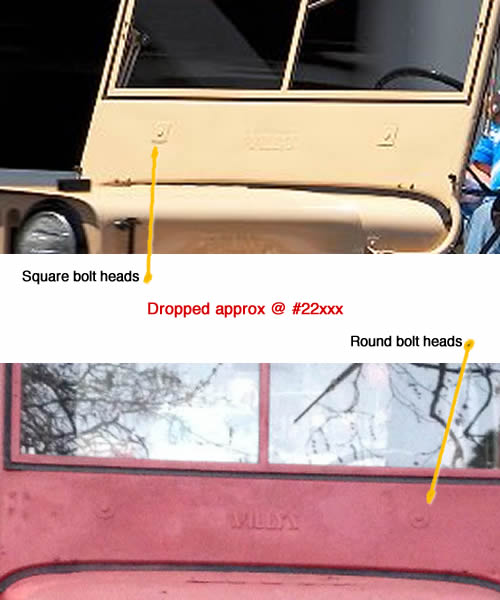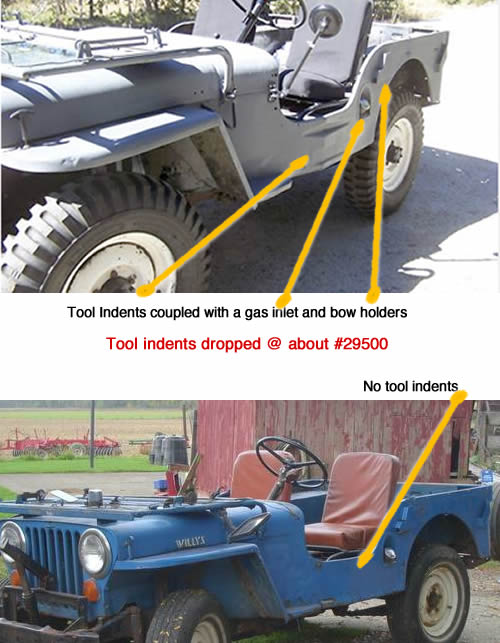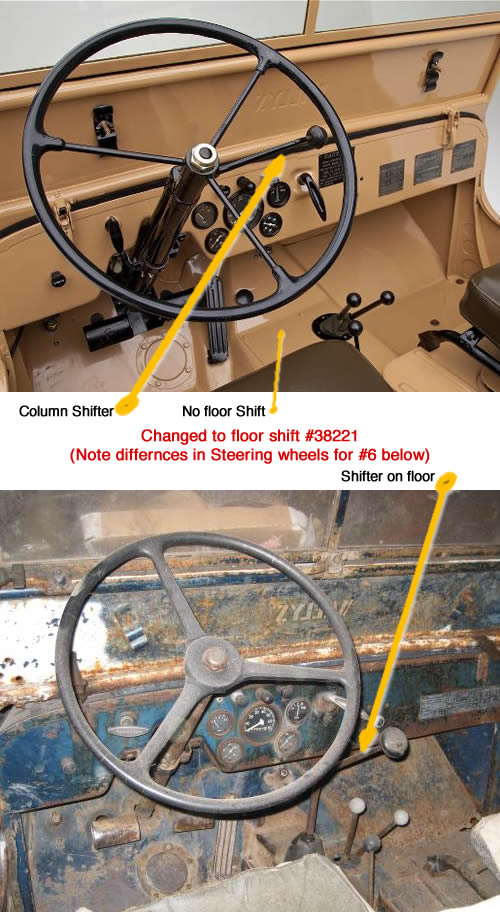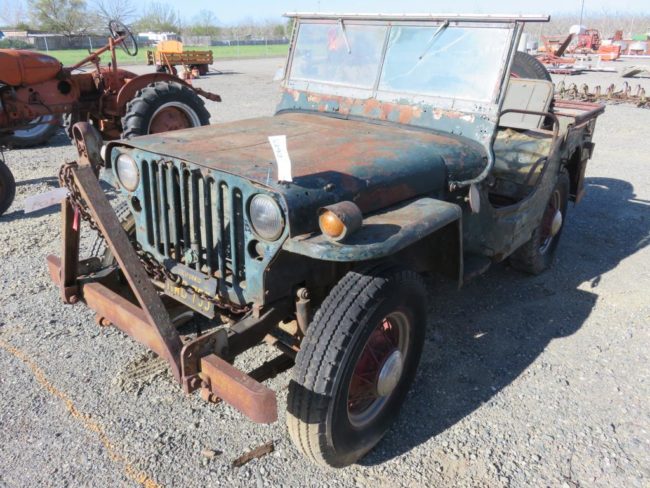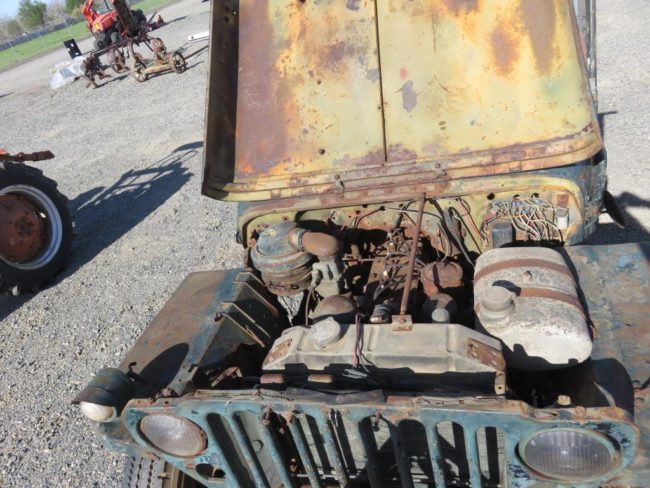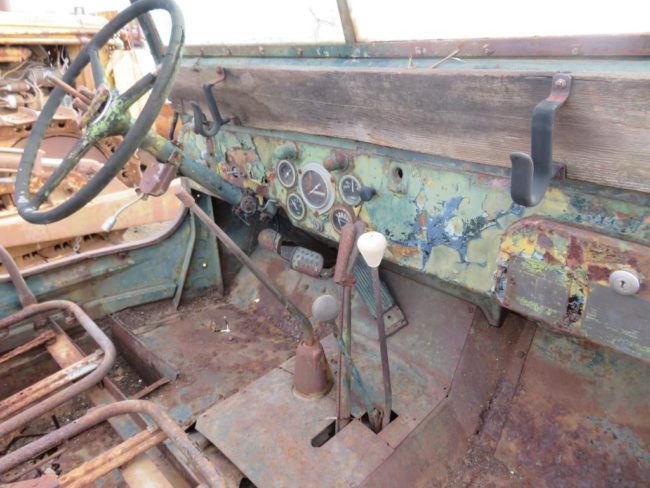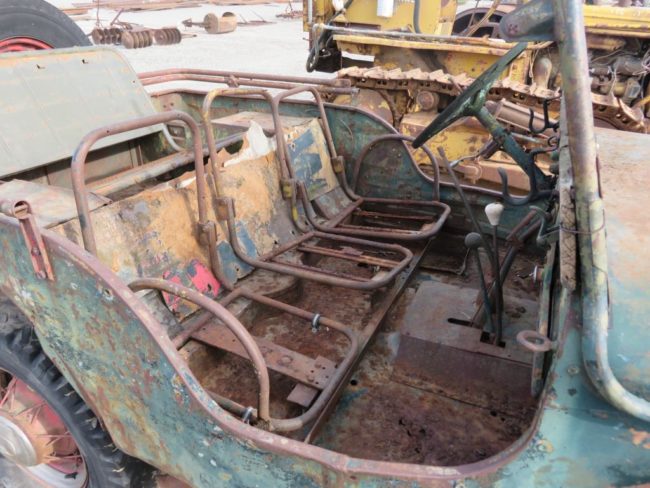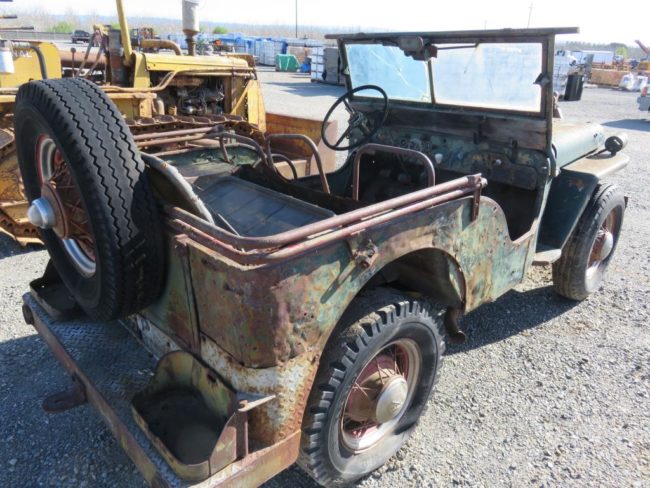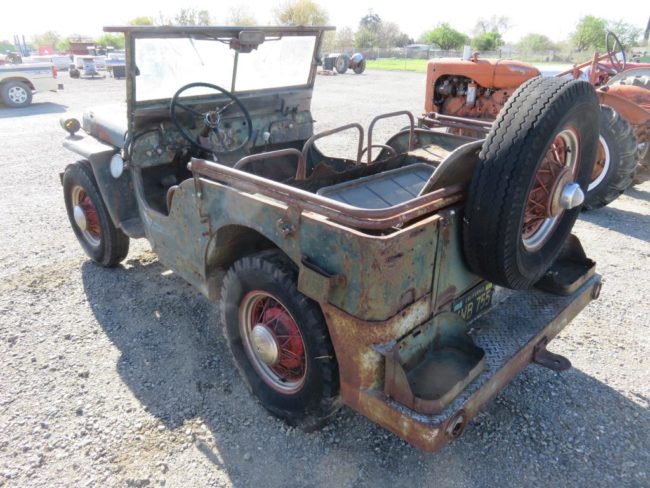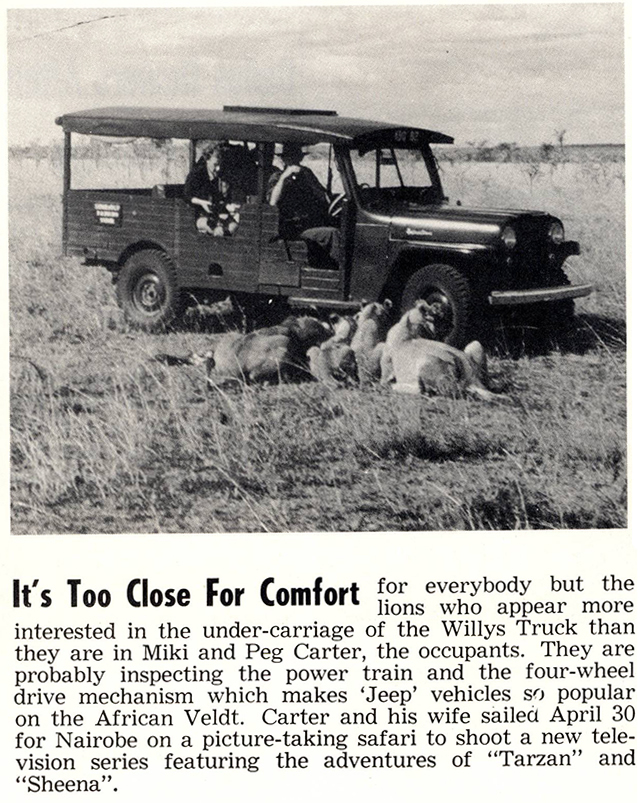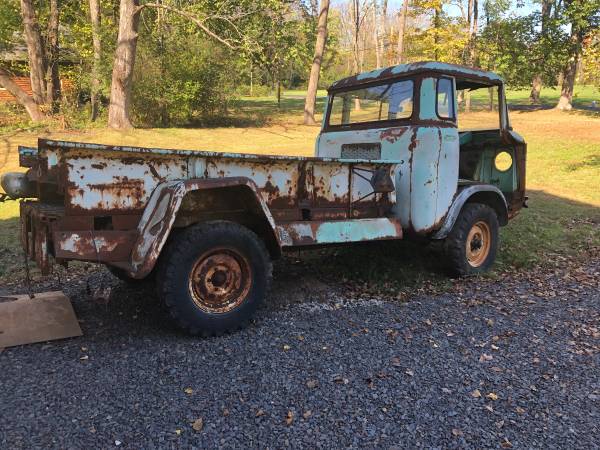I put the body on and placed the seats on their mounts. The body slopes backward a bit, but that will be fixed when I put the correct suspension brackets on the back.
March 2008 Engine Mounts
The CJ-5 I bought last year had been modified to accept a GM 350. I really liked the way they put together the engine mounts, so I chose to reuse the mounts and then modified my frame to accept the mounts.
To make the mounts, I took the standard buick v6 mounts and removed the rubber blocks, leaving only the steel. Then, I cut and welded some 3×3 square tubing to the mounts.
To make the holders that are welded to the frame, I used some recycled angle iron and added side braces to create the triangular look. I look this setup much better than what I did in my first jeep.
March 2008 aligning the Engine, tranny and TC
The tricky part of putting the engine, transmission and TC into position was making sure the TC was in the right location. If I got it back into the right place, I would not have to change the lengths of the drivelines. Fortunately, I had plenty of room for the engine, so I had lots of flexibility upfront.
Once Transfercase was in place, then I could position and weld the engine mounts.
March 2008 Frame Rebuild part 2
These shots show the painted frame with the Dana 44 rear and Dana 30 front painted and attached.
January 2008 Dana 44 Putting it together with a Detroit Locker
With my Dana 44 all taken apart (See article below), it was time to put everything back together. One aspect I have left out of the rebuild process is the importance I placed on using the appropriate language to assemble and disassemble the R&P properly; lets just say I'm glad my children weren't about.
Gathering tools and parts
In terms of parts, I needed to gather a rebuild kit, a locker, and axle kits. Using Craigslist, I found a locker for 3:73 gearing locally for $325. The rebuild kit I got at half price from a jeeper in Bend, Oregon. The axle bearings, cones, and outer seals were purchased online through Tellico4x4.com. The inner axle seals I purchased at Schucks. At first, when I realized I had forgotten to order these (oops), I went to tellico's website. The seals themselves were around $5 a piece, but the cost for shipping was going to more than double the price. I thought that was ridiculous. So, I dropped by the local Schucks to see what it would cost to get the seals (I figured they would have to order them). Well, to my surprise, they had them in stock! $10 later, I was out the door with them.
January 2008 Dana 44 Taking it apart
The Goal .. take apart my Dana 44 housing and install a Detroit Locker along with new bearings and seals. Sounds easy enough, right?
When building my last jeep, I did not have to rebuild either of the axle housings. In the rear I had a Dana 44 from a mail jeep. Mail jeeps come with detroit lockers: note that the housing is a little narrower than a standard jeep by approx 2". To fix this, you can have some shims machined that will allow you to use standard flanged jeep axles.
Fast forward to the new jeep. I had a Dana 44 I knew nothing about and a detroit locker I wanted to install inside it. I figured this would be a good opportunity to learn about ring and pinions; and, learn a thing or two I did!
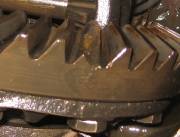 The First Issue – Broken teeth
The First Issue – Broken teeth
Naturally, the first step was to pull off the housing cover and examine the condition of the gears. Unfortunately, the news was not good. I quickly discovered that I had a very broken tooth on the ring gear.
Interestingly, there was no evidence of broken pieces in the oil. This lead me to suspect that the previous owner may have discovered the damage while changing the gear oil and 'forgotten' to mention it to me. Also, once I pulled everything apart, I would also find the pinion gear broken as well.
February 2008 Fiberglass Seats
 Last year I purchased some plastic racing seats to put into Gus. However, I was never very happy with them. I never felt like I fit as well in them as I did in the seats I put into my first jeep. After searching for months for seats, I finally discovered a pair of beat up seats exactly like what I used to own on Craigslist for only $20.
Last year I purchased some plastic racing seats to put into Gus. However, I was never very happy with them. I never felt like I fit as well in them as I did in the seats I put into my first jeep. After searching for months for seats, I finally discovered a pair of beat up seats exactly like what I used to own on Craigslist for only $20.
To get them to meet my my needs, I needed to repair the fiberglass (extensive holes and cracks) and then drill holes for side belts and shoulder belts.
Fall 2007 — Gus’s Frame Makeover

 At left is a pretty stock CJ-5 frame. There were some cracks where the front crossmember attached to the passenger side frame rail. Because of this, I felt the crossmember had to go so I could box in the front of the frame.
At left is a pretty stock CJ-5 frame. There were some cracks where the front crossmember attached to the passenger side frame rail. Because of this, I felt the crossmember had to go so I could box in the front of the frame.
At the back of the frame, the driver’s side was slightly lower than the passenger side. Also, because I wanted to outboard the back springs, I needed to add a bracket onto the side of the frame to help support both the front and the back of the springs.
To make all these changes meant a great deal of work .. welding, grinding (and welding and grinding again) and painting. I am pleased with the results.
Click here to see many more pics of the frame transformation.
The Meeker Trail aka the Naches Trail
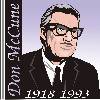 I've heard rumors that a TV show in the 1960s did an episode on the Naches Trail. Good News! I finally found the episode, which was created by Exploration Northwest. The best news is you can buy a copy of it and some other early jeep videos on DVD from the Don McCune Library.
I've heard rumors that a TV show in the 1960s did an episode on the Naches Trail. Good News! I finally found the episode, which was created by Exploration Northwest. The best news is you can buy a copy of it and some other early jeep videos on DVD from the Don McCune Library.
Jeeping 1 (Click link and scroll down to Jeeping 1)
This DVD features 3 episodes:
1. The Meeker Trail: "Join this spine-rattling trip with the Yakima Ridge Runners Jeep Club as they retrace the oldest route across the Cascades: Naches Pass. Filmed in black-and-white in 1965, it is based on Ezra Meeker's book "Pioneer Reminiscences of Puget Sound", which recounts traversing this old Indian trail with the first immigrant wagon train of 148 people in 1853."
2. The Doe Run: "The female members of the Seattle Jeep Club leave their families at home and enjoy a weekend 'Doe Run' on the rugged backcountry roads of the Cle Elum and Salmon La Sac area in the Cascade Mountains." (The WWJC club did something similar about this time – my mom and grandma went)
3. The Mud Race: " Yakima Ridge Runners Jeep Club race their specially-equipped jeeps through a mud-hole track in central Washington."
The Desert Races DVD (Click link and scroll down to Desert Races)
This DVD features 3 episodes
1. Mattawa 100: "The 1975 Mattawa 100 features 750 dirt bikes racing across 100 miles of sand and sagebrush near the eastern Washington town of Mattawa. Aerial and slow-motion photography offers an exciting view along with comments by contestants. The Everett Highriders Jeep Club and the Stump Jumpers Motorcycle Club assisted in the event". (I think I was at this race. Our jeep club was helping run a checkpoint. Guys were coming to the checkpoint bloody from falling. Very memorable).
2. The Sunfair 300: "Sponsored by the Washington Off-Road Racing Association, the Sunfair 300 is a desert race with 4-wheel-drive vehicles and rails (dune buggies) on a 225-mile course near Yakima that ranks as one of the toughest in the nation! Members of the Yakima Ridge Runners staff the race course check points." (I believe this was what my original racing jeep — that I purchased for $600 — was built to compete in).
3. A retrospective of the life of the host, Don McCune.
1948 CJ-2A San Diego, Ca $4500 obo
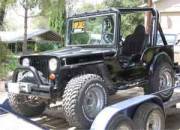 I find this jeep slightly puzzling. I love the nice detail and old school upgrades — the full roll cage, the extra large windshield, a good front bumper mod, the nice paint job, updated seats — yet it still sports an F-head? This jeep looks like it should go fast, but can’t.
I find this jeep slightly puzzling. I love the nice detail and old school upgrades — the full roll cage, the extra large windshield, a good front bumper mod, the nice paint job, updated seats — yet it still sports an F-head? This jeep looks like it should go fast, but can’t.
“Fresh F-Head 4 Cyl., new exaust, 3 speed w/overdrive, 8000# Winch, full roll cage, front disc brakes, custom tall windshield, custom seats, rock bars, custom bumpers — $4,500 o.b.o.,”
1946 Sand Jeep
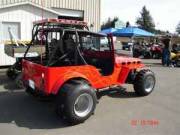 Looks to be street legal. Has lights and a license plate.
Looks to be street legal. Has lights and a license plate.
“Selling my toy. 1946 Willys Jeep .The only thing on the jeep that is a 46 Willys is the Tub and Title. Motor is a Pontiac 468 with 1970 Ram Air heads 500+ HP, New narrowed 9″ 31 spline axels with limited slip,frame lengthened 12”,aluminum hood,aluminum fenders and tail gate.Turbo 400,new transfer case,new paint,custom headers. Have full canvas and doors.two sets tires sand and street. street legal, Jeep is at the dunes at Coos Bay until April then will be in Grants Pass …. “
April 2007 Purchasing the CJ-3A Body and parts
I purchased this jeep CJ-3A body and parts for $450. It came without running gear, but with a recently rebuilt engine and transmission. I just happened to have a rolling frame without a body, so I put all the parts I didn’t want on the rolling frame and sold that. I ended up making all my money back from this purchase and was left with the fenders, hood, windshield and the data plate that goes on the dashboard 🙂
March 2007 Buying the CJ-5
I decided to purchase a CJ-5 to get a better frame and running gear. Here's some pics of it. It's a 1973 CJ-5 with a Chev 350, a sm420 tranny, center rear differential with the dana 20. I ended up parting out most of it.
Biscuit’s Bobcat Body Makeover
In January of 2007 I traded some cherokee axles for a Bobcat fiberglass body. It was a bit hacked up, but after many hours I revived it. Here’s an accounting of some of the work.
The body before any work was done:
Body after some trimming:
Unknown Body out of California
ANSWERS to 1951 Salesman Quiz
::ANSWERS ::
Here are the answers to the Salesman Quiz. To see or take the original quiz, click on this link.
Thanks to Colin for finding the answers.
1. There are ……….. different Willys chassis.
(1) 2
(2) 5 — 2WD station wagon and panel; 2 WD Jeepster; 4WD station wagon and panel; 4WD pickup truck; 4WD Jeep (CJ3A and M38)
(3) 6
(4) 8
2. In the Jeepster, the basic rugged frame is made …………………… to compensate for the open-type body.
(1) more flexible
(2) stronger — Jeepster frame has a huge X member in the middle for strength.
(3) more streamlined
3. Planadyne suspension provides a comfortable, big-car ride without ……………………..
(1) shock absorbers
(2) unsprung weight
(3) excessive weight and long wheelbase — Planadyne suspension provides comfort and ride without excessive weight and long wheelbase.
4. Hotchkiss drive uses the car’s ……………………………… to transmit the push of the drive wheels to the total car.
(1) drive line — Hotchkiss drive uses the driveline to get power to the drive wheels
(2) rear springs
(3) torque tube
5. A measure of long clutch-life is ……………………, and on this basis, Willys clutches are outstanding.
(1) frictional area per horse-power handled
(2) horsepower per cubic inch of piston displacement — Long clutch life attributed to frictional area per horsepower handled.
(3) area of clutch throwout bearing surface
6. The Hurricane engine’s ………………….. is in the cylinder head, resulting in better control of the temperature of the air-fuel mixture
(1) intake manifold — The Hurricane engine has the intake manifold cast into the cylinder head.
(2) carburetor
(3) exhaust manifold
7. The F-head design of the Hurricane engine permits ………………..
(1) a larger intake valve — The F-head design permits a larger intake valve.
(2) a smaller exhaust valve
(3) location of the exhaust valve in the cylinder head
8. The Hurricane engine has the high compression ratio of ………………… yet premium priced gasoline is not required.
(1) 7.2 to 1
(2) 7.4 to 1 — The Hurricane engine has the option of 7.4 to 1 compression ratio( Willys ad from 1950-51)
(3) 7.8 to 1
9. In the Hurricane engine the arrangement of intake and exhaust valves is ………………..
(1) both in the cylinder head.
(2) both in the block.
(3) intake valve in head, exhaust valve in block. — Hurricane engine design has the intake valves in the head, exhaust valves in the block.
10. On the basis of horse-power per cubic inch of piston displacement, the Hurricane engine is the ………………….full-sized American-built automobile engine.
(1) lightest-weight
(2) most efficient — Hurricane engine is the most efficient engine based on horsepower per cubic inch (.53 horsepwer per cubic inch) Divide horsepower(72) by cubic inches (134) or 75hp divided by 134= .55 hp per cubic inch depending on which horsepower rating Willys used at the time
(3) highest compression
11. All of the Willy chassis are designed and built …………….
(1) identical in construction.
(2) to do their particular transportation jobs. — All Willys chassis are designed for the job they are intended to do.
(3) with excess weight to get comfort.
12. The Willys ………………… is universally recognized as the most dependable 4-cylinder, L-head engine in the history of American motor cars.
(1) Hurricane engine
(2) Lightning engine
(3) ‘Jeep’ “Go-Devil” Engine — The Willys “Go-Devil” is the most dependable L-head 4 cylinder engine in the history of American cars. ( Hurricane was 4 cylinder F-head, Lightning was an L head 6 cylinder engine)
4-wheel-steers
UPDATE: DRAFT … I NEVER FINISHED THIS POST
Here’s the most complete information on 4 Wheel Steering that I could find. I found it at JeepStation.com (http://jeepstation.com/main/?q=node/18). Looks like Ford built 100, Willys 50 and Bantam 50. If anyone knows more, please add info. This is likely a GPW-4WS.
BRC-40-4WS: American Bantam Jeep, 4 Wheel Steering – 50 built. (62 according to this site)
MA-4WS: Willys Military model A with 4 Wheel Steering – 50 built.
GP-4WS: Ford First model Military with 4 Wheel Steering – 50 built.
GPW-4WS: Ford Military 80″ wheelbase, Willys design with 4 Wheel Steering – 50 built.
How to Identify a Very Early CJ-2A (VEC) Jeep
UPDATE: Currently no comments allowed.
As editor of eWillys, one question readers often ask is how to differentiate between a Very Early CJ-2A (VEC) and a regular CJ-2A. The visual and timeline explanations herein should help reader better understand how the VEC evolved into the more recognizeable CJ-2A.
Over the five year life of the CJ-2A (1945-1949) the CJ-2A underwent changes from time to time. Some were very noticable, such as the disappearance of the driver’s side tool indents, while others were less noticible, such as the mid-1947 parking light change.
The biggest changes were made during the first year of production (roughtly 08/45 – 08/46), hence these early CJs developed a reputation for being different from later CJ-2As. At some point, these early CJs were designated VEC CJ-2As, though who crowned as such is not known. Because Willys-Overland never officially identified the VEC as a specific model, the term does not have a precise definition nor an exact serial number. For example, I’ve seen an ending serial number of #34530 labeled the last VEC, yet the column shift wasn’t abandoned on the 2A until #38221, so maybe that’s a more natural end point? However, I’m not here to debate the proper ending point for VEC production. Instead, I just want to highlight what people new to VECs should consider when trying to identify them.
One great source of information regarding the CJ-2A alteration history is at the CJ-2A History Page. I’ve found that page very helpful in my research. While I highlight six items below, there are many other subtle changes that occur over the life of the CJ-2A. For example, this CJ-2A.com link highlights how the windshield adjusters changed. And this link from the CJ-2A Page provides a long list of minor changes and their associated part numbers.
SIX MAJOR VEC-ITEMS YOU WILL WANT TO WATCH FOR WHEN LOOKING AT CJ-2As:
1. Floating Hubs Dropped: In early 1946 at serial number #13454 Willys-Overland switched from full floating rear ends to the standard rear end. Of course, sometimes people have replaced later CJ-2A rear end with WWII military rear ends OR added aftermarket full floating axle packages to standard CJ-2A rear ends. Thus, this identifier is never a conclusive indication of a VEC.
strong>2. Exhaust changed: The first VEC was reportedly built with the muffler under the driver’s seat. The muffler was switched to the passenger side from #10002 – #18638. After that, the exhaust was routed to the rear of the jeep, with the muffler located under the rear cargo area.
3. Square bow holder bolts on the windshield: Bolts were inserted through the windshield to afix small hangers to the windshield. These hangers were used to carry the straight portions of the soft top bows (the curved portions were intended to be stored on the side of the jeep). The bow holder bolts changed from square to round about 22XXX.
4. Tool indents dropped: At about serial number #29500 the tool indents were eliminated from the CJ-2A design. The tool indents can be confusing for some new jeep folks, as they are often used to identify WWII jeeps. However, most anytime you see tool indents AND a gas inlet, it’s a sign of a VEC CJ-2A. If there are bow holders (not always there), the body is just that much easier to spot.
5. Column shift dropped: At #38221 the column shift was changed to a floor shift, though apparently a column shift option was available(?).
6. Steering wheel switched from spoke to resin (the photo above illustrates this change): Willys-Overland changed the steering wheel from the metal spoked version commonly found on WWII jeeps for a solid resin steering wheel. However, this wasn’t the same wheel, as WWII wheels were green, while the CJ-2As were black.
There is some debate about when the switch occurred (see this CJ-2A Page forum discussion), but it seems to have been after #18092 and before roughly #26xxx. While an official document puts the changeover at #38070, the anecdotal evidence suggests it happened earlier. No matter when it happened, if you see a spoked wheel on a CJ-2A, look closer for other VEC elements.
(Bonus) 7. Data plate changes: Anytime you see three data plates on the dash instead of one take a closer look at the jeep. The three dash system was a hold over from the WWII jeeps. Over the early life of CJ-2As there were several variations of the three plate design. Then sometime around #46xxx the three plate system gave way to the one plate motif, though that design also changed a few times. The CJ-2A.com site has a nice overview of the different plate types:
http://www.cj-2a.com/oldsite/marks/dataplates/survey
Of course, one of the greatest challenges in looking at old jeeps is the problem of part interchangeability. The replacment of later parts on early jeeps, along with additional modifications, can make identifying VECs a challenging task. Hopefully, this essay helps make the task a little easier.
1942 GPW Chico, CA CalBid
Bill spotted this customized GPW. That rear bumper looks pretty hardy! Is that a spare gas tank or water tank in the engine compartment? How about the three “bucket” seats up front. Looks to have an inline flathead 6 of some type. Auction is at $950 and it ends today.
( scroll down to #109)
“does not start”
Tour Jeep in Africa
UPDATE: The was first published September 23, 2015: Perhaps one of the earliest wagons used as a tour wagon?
This unique tour jeep truck was featured in the April 1955 issue of Willys News.
1960 FC-170 Chalfont, PA $900
UPDATE: Still Available.
(10/20/2017) Not sure how much value is here.
https://allentown.craigslist.org/cto/d/willys-jeep-fc170-forward-control/6829233009.html
“No title very rough condition.
Complete drivetrain
Solid frame
Pictures tell the rest
Please call for more info
I do not want to part out selling whole
Must be towed I can tow local for fee
Come make offer don’t want to destroy this rare piece of history”

